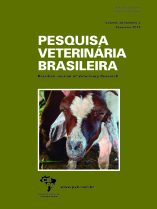 |
|
|
|
Year 2018 - Volume 38, Number 2
|

|
Combination of Transversus abdominis plane block and Serratus plane block anesthesia in dogs submitted to masctetomy, 38(2):315-319
|
ABSTRACT.- Teixeira L.G., Pujol M.D., Pazzim F.A., Souza R.P. & Fadel L. 2018. Combination of Transversus abdominis plane block and Serratus plane block anesthesia in dogs submitted to masctetomy. [Combinação dos bloqueios anestésicos do plano transverso abdominal e do plano serrátil em cadelas submetidas à mastectomia.] Pesquisa Veterinária Brasileira 38(2):315-319. Hospital Veterinário, Universidade Luterana do Brasil, Av. Farroupilha 8001, São José, Canoas, RS 92425-900, Brazil. E-mail: lucianateixeira@gmail.com
This paper pretends to demonstrate the effect of the combination of transversus abdominis plane block (TAP block) and Serratus plane block (SP block) techniques in analgesia of 4 dogs undergoing total unilateral mastectomy. Dogs were premedicated with methadone (0.5mg.kg-1) intramuscularly. Anesthesia was induced with propofol (6mg.kg-1) and midazolam (0.3mg.kg-1) and maintained with isoflurane. SP and TAP block were performed unilaterally using ultrasound by the injection of bupivacaine 0.25% (0.3mL kg-1) diluted with NaCl solution 1:1. Heart rate (HR), respiratory rate (f), non-invasive arterial pressure, esophageal temperature (T), oxygen saturation (SpO2) and electrocardiogram were monitored continuously. Animals were monitored for two and four hours after extubation for pain by using the Canine Acute Pain Scale from Colorado State University. Two hours after extubation, tramadol (4mg.kg-1) and dipyrone (25mg.kg-1) was administered to all dogs. It was not observed any alteration on cardiac rhythm. HR, f, T and mean arterial pressure remained below the preincisional values for all dogs. No dog required intraoperative rescue analgesia. Recovery from anesthesia was without any complication. All animals scored 0 (0/5) at pain scale, two and four hours after extubation and none of them expressed concern over the surgical wound. Dogs were able to walk before two hours after extubation. The combination of both techniques is effective in anesthetic blocking the thoracic and abdominal walls and it is suggested both may be included in the multimodal analgesia protocols for this type of surgery. |
| |
|
|
| |
|
 |